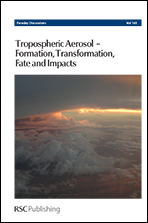Despite major progress in the understanding of properties of tropospheric aerosol particles, it remains challenging to understand their physical state and morphology. To obtain more detailed knowledge of the phases, phase transitions and morphologies of internally mixed organic/inorganic aerosol particles, we evaluated liquid–liquid phase separation (LLPS), deliquescence relative humidity (DRH) and efflorescence relative humidity (ERH) of 33 organic/ammonium sulfate (AS)/H2O systems from our own and literature data. The organic fraction consists of single compounds or mixtures with up to ten aliphatic and/or aromatic components with carboxylic acid, hydroxyl, carbonyl, ether, and ester functionalities, covering O : C ratios between 0.29 and 1.33. Thirteen out of these 33 systems did not show LLPS for any of the studied organic-to-inorganic mixing ratios, sixteen underwent LLPS showing core–shell morphology, and four showed both core–shell and partially engulfed configurations depending on the organic-to-inorganic ratio and RH. In all cases the organic fractions of the systems with partially engulfed configurations consisted of dicarboxylic acids. AS in mixed organic/AS/H2O particles deliquesced between 70 and 84% RH. AS effloresced below 58% RH or remained in a one-liquid-phase state. AS in droplets with LLPS always showed efflorescence with ERH between 30 and 50% RH, providing clear evidence that the presence of LLPS facilitates AS efflorescence. Spreading coefficients of the organic-rich phase on the AS-rich phase for systems containing polyethylene glycol 400 (PEG-400) and a mixture of dicarboxylic acids are in agreement with the optically observed morphologies of droplets deposited on the hydrophobic substrate. Analysis of high resolution elastic Mie resonance spectra allowed the detection of LLPS for single levitated droplets consisting of PEG-400/AS/H2O, whereas LLPS was difficult to detect in (2-methylglutaric acid + 3-methylglutaric acid + 2,2-dimethylsuccinic acid)/AS/H2O. Measured Mie spectra of PEG-400/AS/H2O at 93.5% and at 80.9% RH agreed with computed Mie spectra for a homogeneous and a core–shell configuration, respectively, confirming the results obtained from droplets deposited on a hydrophobic substrate. Based on the presented evidence, we therefore consider the core–shell morphology to be the prevalent configuration of liquid–liquid-phase-separated tropospheric organic/AS/H2O particles.

 Please wait while we load your content...
Please wait while we load your content...